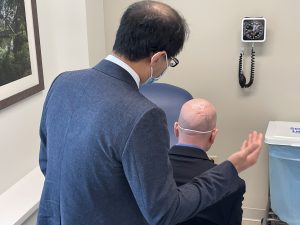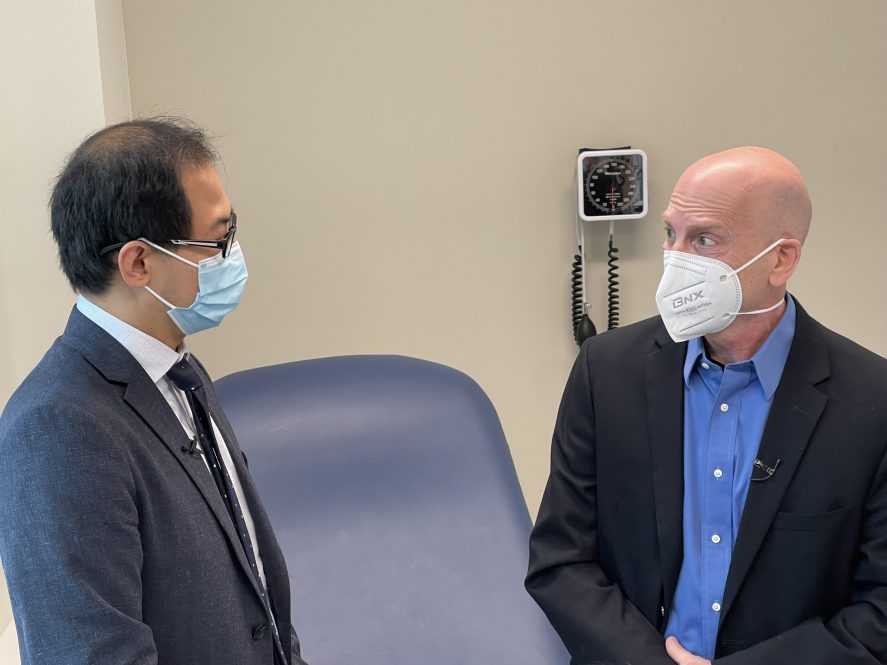Ken Jones of Canton hadn’t been to a dermatologist in about twenty years, so when his wife saw a suspicious spot on his back, she suggested he have it checked out by a dermatologist.
His dermatologist performed a full body scan and the spot on his back was normal, but it was a suspicious spot on his head that concerned the dermatologist. A biopsy was performed and was inconclusive, however, the dermatologist thought it was suspicious enough that it would eventually become a problem and referred Jones to Dr. Hao Feng, a Mohs micrographic surgeon and the director of Laser Surgery and Cosmetic Dermatology at UConn Health’s Dermatology Department.
“Dermatologists are skilled at looking at your skin and can see things that are concerning,” says Feng. “If you have skin you are at risk for skin cancer, although some are at higher risk than others.”
Anyone can get skin cancer, but people with certain characteristics are at greater risk:
- A lighter natural skin color.
- Skin that burns, freckles, reddens easily, or becomes painful in the sun.
- Blue or green eyes.
- Blond or red hair.
- Certain types and a large number of moles.
- A family history of skin cancer.
- A personal history of skin cancer.
- Older age.
When Feng met Jones, he too was concerned about the lesion on his scalp and performed a procedure known as “Slow Mohs”, a modified version of Mohs surgery, which has the highest cure rate of any removal method. This technique is used for melanomas on the head, neck, hands, and feet. “Slow Mohs” tracks the tumor and conserves normal skin.
The cancer is not visible to the naked eye, and therefore the doctor does not know where cancer starts and where it ends, so Feng used “Slow Mohs”, a staged surgical excision used to precisely remove the melanoma while trying to save as much normal healthy skin around it.
The first margin removed confirmed that Jones had melanoma in situ which means it has been caught very early at Stage 0 and had not grown deeper than the top layer of the skin.
 The tissue was processed and the dermatopathologist was able to pinpoint that there were still some margins that contained cancerous cells. After two more staged excisions to remove the remainder of the melanoma cancer cells that could only be seen under a microscope, Feng had removed it all with clean lines and prepared for reconstructive surgery.
The tissue was processed and the dermatopathologist was able to pinpoint that there were still some margins that contained cancerous cells. After two more staged excisions to remove the remainder of the melanoma cancer cells that could only be seen under a microscope, Feng had removed it all with clean lines and prepared for reconstructive surgery.
The skin on the head is tight and Feng had to create a flap and several incisions so the skin would cover the entire incision.
The scar takes a full 12 months to heal with most of the initial healing beginning in the first month.
“Dr. Feng is an expert and sewed me back together,” says Jones “It’s incredible how quickly it is healing.”
Jones was never a sun worshiper and used sunscreen, however being bald, his continuous exposure to the sun became an issue. Now Jones wears a hat, something he hadn’t previously done.
To protect your skin, Feng recommends practicing good sun protection year-round, not only to protect your skin from future skin cancer, but also from the damage the sun does to create wrinkles, spots, and other sun damage that causes you to look older.
If you are going outside even on cloudy days – put sunscreen on, there is also clothing that provides protection and wide-brimmed hats are important coverage.
Feng says that most people don’t use enough sunscreen. “They buy a big 16-ounce container and use it the whole summer and sometimes into the next; it shouldn’t last you that long.”
According to Feng, a shot glass full of sunscreen should be applied every two to three hours while out in the sun. He is not a fan of spray sunscreen which usually contains Benzene and tends to not provide full coverage or even applications but prefers that over not using any protection.
Jones’s advice to others is to put your health first and get your skin checked regularly, especially if you are at risk for skin cancer.
A skin cancer screening is a visual exam of the skin that is done by your dermatologist. The screening checks the skin for moles, birthmarks, or other marks that are unusual in color, size, shape, or texture. Certain unusual marks may be signs of skin cancer. Your dermatologist can decide how often you should be checked based on your age and baseline risk factor.
If you have spots that don’t seem right or are similar to other lesions you have, especially if over time it keeps bleeding, scabbing, or not healing appropriately, call your dermatologist to be seen sooner.
If you have suspect lesions or concerns about skin cancer, contact UConn Dermatology at 860-670-4600



